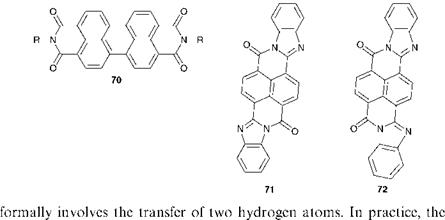The quinone-hydroquinone system represents a classic example of a fast, reversible redox system. This type of reversible redox reaction is characteristic of many inorganic systems, such as the interchange between oxidation states in transition metal ions, but it is relatively uncommon in organic chemistry. The reduction of benzoquinone to hydroquinone
|
|
reversible reaction involves the stepwise transfer of two electrons from the reducing agent as shown in Scheme 4.1. Commonly, these redox reactions are carried out in alkaline media, in which case the unprotonated semi — quinone is first formed and the dianion is the final reduction product as illustrated in the scheme. In media where protons are available a series of acid-base equilibria are also involved. A wide range of dicarbonyl compounds undergo this type of reaction, including the anthraquinones, indigoid derivatives and perinones. The reduction-oxidation of carbonyl dyes is used practically in the chemistry of vat dyeing of cellulosic fibres (Chapter 7). In this process, the insoluble colorant is treated with a reducing agent in an alkaline medium to give the reduced or ‘leuco’ form. After application of the ‘leuco’ form of the dye to the fibre, the process is reversed and the coloured dye is generated by oxidation. The reducing agents commonly used include sodium dithionite (Na2S2O4) and sodium hydrogen sulfite, while appropriate oxidising agents include sodium dichromate, iron(iii), atmospheric oxygen and hydrogen peroxide.
 27 сентября, 2015
27 сентября, 2015  Pokraskin
Pokraskin 
 Опубликовано в рубрике
Опубликовано в рубрике 